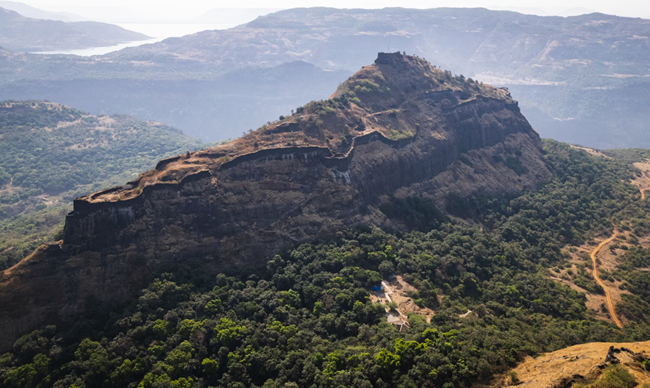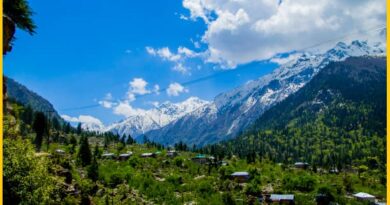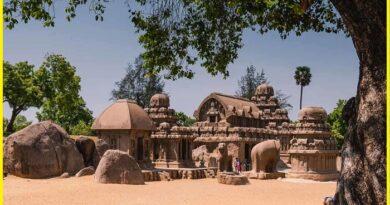Rajmachi Fort: A Historic Citadel Amidst the Sahyadri Splendor
Rajmachi Fort Lonavala
Rajmachi Fort is a popular historical fortification located near Lonavala in the Indian state of Maharashtra. It’s nestled in the Sahyadri mountain range and holds great significance due to its strategic location and historical background. Rajmachi Fort is about 15 kilometers west of Lonavala and stands at an altitude of around 2710 feet.
The fort has a rich history dating back to the 17th century when it was under the control of various rulers including the Marathas, the Mughals, and the British. It was strategically important for controlling trade routes and was a key stronghold during conflicts. Rajmachi Fort consists of two forts – Shrivardhan Fort and Manaranjan Fort. These two forts are separated by a wide plateau. The architecture of the fort includes massive walls, gates, watchtowers, and various structures.
Trekking to Rajmachi Fort is a popular activity among adventure enthusiasts. The trek offers mesmerizing views of the surrounding valleys, lush greenery, and waterfalls during the monsoon season. Apart from the forts, there are other attractions around Rajmachi, such as the Kondhane Caves, which are ancient Buddhist caves believed to date back to the 1st century BC.
1. Kondhane Caves
The Kondhane Caves are a group of ancient Buddhist caves located near Karjat. The Kondhane Caves are situated in the Kondivade village, approximately 15 kilometers away from Karjat town in the Raigad district of Maharashtra. The caves are nestled amidst lush greenery and surrounded by hills, offering a tranquil and picturesque setting. The Kondhane Caves date back to the 1st century BC, making them over 2,000 years old. They were originally excavated as Buddhist viharas (monasteries) and chaityas (prayer halls) during the Satavahana period. The caves served as a place of residence and worship for Buddhist monks and followers.
The caves feature simple yet elegant architectural designs typical of Buddhist rock-cut caves in Maharashtra. The main cave complex consists of several rock-cut chambers, cells, and prayer halls carved into the hillside. The caves are adorned with intricate sculptures, pillars, and inscriptions, reflecting the craftsmanship of the ancient artisans. The Kondhane Caves hold religious significance for followers of Buddhism and serve as a reminder of the region’s rich cultural and spiritual heritage. Visitors can explore the caves and marvel at the ancient rock-cut architecture while reflecting on the historical and religious context of the site.
2. Rajmachi Fort Trek
The Rajmachi Fort Trek is a thrilling adventure that attracts nature lovers and trekkers from all over. The trek to Rajmachi Fort is renowned for its scenic beauty. As you ascend through the lush green forests of the Sahyadri Mountains, you’ll be treated to breathtaking views of the surrounding valleys, cascading waterfalls, and picturesque landscapes.
Rajmachi Fort holds significant historical importance, having served as a strategic stronghold for various rulers over the centuries. Exploring the fort’s ancient ruins, walls, and structures gives trekkers a glimpse into its storied past. The trek offers a mix of moderate to challenging terrain, making it suitable for both beginners and experienced trekkers. The trail consists of steep ascents, rocky patches, narrow pathways, and dense forests, providing an exhilarating trekking experience.
Rajmachi Fort comprises two distinct forts – Shrivardhan Fort and Manaranjan Fort – separated by a vast plateau. Trekkers have the opportunity to explore both forts and admire their unique architecture and panoramic views. Many trekkers opt to camp overnight at Rajmachi, immersing themselves in the tranquility of nature under the starlit sky. Camping amidst the rugged beauty of the Western Ghats is a memorable experience that allows for relaxation and camaraderie with fellow trekkers.
Best Time to Trek: The ideal time to embark on the Rajmachi Fort Trek is during the post-monsoon season (October to February) when the weather is pleasant and the surroundings are lush green. However, trekking during the monsoon season (June to September) offers a unique experience with gushing waterfalls and verdant landscapes.
Also Read- Lohagad Fort Lonavala-A Historical Fort and the Best Trekking destination
3. Rajmachi Fort in Winter
Exploring Rajmachi Fort during the winter months can be a serene and captivating experience. Winter in the region brings cooler temperatures, creating a refreshing atmosphere for outdoor activities. During the day, the weather is generally mild, making it comfortable for trekking and exploring the fort. However, evenings and early mornings can be quite chilly, so it’s advisable to carry layers to stay warm.
Winter often brings clear skies, offering stunning vistas of the surrounding Sahyadri mountains and valleys from the Fort. The crisp air enhances visibility, allowing you to appreciate the beauty of the landscape and capture breathtaking photos. Winter is considered the off-season for trekking in the Western Ghats, meaning you’re likely to encounter fewer tourists and enjoy a more peaceful experience at Rajmachi Fort. The tranquility of the surroundings adds to the charm of the place, allowing you to connect with nature and soak in the serenity.

Night Camping: Winter nights are perfect for camping under the starry sky near Rajmachi Fort. Setting up campfires adds warmth and creates a cozy ambiance for storytelling and stargazing. Watching the constellations above while surrounded by the tranquility of the mountains can be a memorable experience. Since temperatures can drop significantly during the night, make sure to pack appropriate clothing, including layers, a warm jacket, hat, gloves, and sturdy footwear for trekking. Additionally, carry sufficient food, water, and camping equipment if you plan to stay overnight.
4. Rajmachi Fort in Monsoon
Exploring Rajmachi Fort during the monsoon season offers a unique and captivating experience, but it also comes with its own set of considerations. The monsoon transforms the Sahyadri Mountains into a lush green paradise. The landscape around Rajmachi Fort bursts with vibrant foliage, and the hillsides are adorned with cascading waterfalls. The scenic beauty is truly breathtaking during this time.
The air is cool and refreshing, providing relief from the summer heat. However, the humidity can be high, so be prepared for damp conditions during your trek. The monsoon season brings the waterfalls surrounding Rajmachi Fort to life. You’ll encounter numerous streams and waterfalls along the trekking route, offering picturesque spots to rest and admire the natural beauty. Some of the waterfalls may be strong, so exercise caution while crossing them.
The mountains often get shrouded in mist and fog, creating a mystical ambiance. While this adds to the beauty of the surroundings, it can also affect visibility, especially during heavy rainfall. Make sure to carry waterproof gear and be cautious while trekking on slippery trails. Trekking to Rajmachi Fort during the monsoon season can be more challenging due to muddy and slippery trails. It’s essential to wear sturdy footwear with good grip and proceed with caution, especially on steep ascents and descents.
While the monsoon season attracts fewer tourists compared to the peak season, it’s still advisable to check weather conditions and trail accessibility before planning your visit. Some trails may be closed or have restricted access during heavy rainfall due to safety concerns.
5. Rajmachi Fort Waterfall
The waterfalls around Rajmachi Fort are a captivating sight, especially during the monsoon season when they come alive with cascading water. Here are some notable waterfalls you might encounter around Rajmachi Fort-
Kataldhar Waterfall: This is one of the tallest waterfalls in Maharashtra and is located near Rajmachi Fort. Kataldhar waterfall plunges from a height of over 350 feet, creating a mesmerizing spectacle against the backdrop of lush greenery. It’s a popular destination for trekkers and nature enthusiasts seeking the thrill of witnessing a majestic waterfall in the Sahyadri Mountains.
Ulhas Valley Waterfall: The Ulhas Valley, surrounding Rajmachi Fort, is dotted with numerous smaller waterfalls that come to life during the monsoon season. These cascades add to the beauty of the landscape, offering tranquil spots to rest and admire nature’s bounty. While not as towering as Kataldhar, these smaller waterfalls contribute to the enchanting ambiance of the region.
Dhom Dam Waterfall: While not directly adjacent to Rajmachi Fort, the Dhom Dam waterfall is located in the vicinity and can be seen from certain vantage points during the trek. The waterfall is formed by the overflow of water from the Dhom Dam reservoir and is a picturesque sight, especially during the monsoon when the water levels are high.
Valvan Waterfall: Valvan waterfall is another notable cascade near Rajmachi Fort, located in the Valvan village near Lonavala. While not directly part of the trek to Rajmachi, visitors often pass through Lonavala and may choose to explore the Valvan waterfall as an additional attraction. The waterfall is surrounded by lush greenery and is a popular picnic spot for locals and tourists alike.
Bhivpuri Waterfall: Bhivpuri waterfall is located near Karjat, which is a common starting point for treks to Rajmachi Fort. While the waterfall is not directly en route to Rajmachi, visitors may pass through the area and have the opportunity to explore Bhivpuri waterfall. It’s a serene spot surrounded by dense forests and offers a refreshing respite during the trek.



